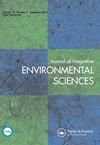中国环境空气质量标准的演变与比较评价
IF 3.5
4区 环境科学与生态学
Q3 ENVIRONMENTAL SCIENCES
Journal of Integrative Environmental Sciences
Pub Date : 2016-02-18
DOI:10.1080/1943815X.2016.1150301
引用次数: 47
摘要
摘要环境空气污染与经济发展、能源消耗、大气环境和公众健康密切相关,已成为中国的关键问题之一。环境空气质量标准是环境管理的准则和控制大气污染排放的基础。为适应不断变化的环境形势,中国环境空气质量标准GB 3095于1982年制定,1996年修订,2000年修订,最近一次修订是在2012年。本文对中国环境空气质量标准的演变进行了历史分析,重点介绍了关键污染物及其浓度阈值,并进行了比较分析,说明了与重要发达国家和国际组织的差异。结果表明,中国环境空气质量标准污染物项目逐步更新,浓度阈值更加严格,规划更加科学。尽管经济、科技和环境发展水平存在差异,但中国最新的环境空气质量标准GB 3095-2012与其他重要标准具有可比性。但是,为了确保标准的有效实施,需要宏观政策和技术措施的支持。本文章由计算机程序翻译,如有差异,请以英文原文为准。
Evolution and comparative assessment of ambient air quality standards in China
Abstract Ambient air pollution has become one of the key issues in China because it is highly associated with economic development, energy consumption, the atmospheric environment, and public health. Ambient air quality standards are guidelines of environmental management and fundamentals of air pollution emission control. To adapt to the changing environmental situation, China’s ambient air quality standard GB 3095 was established in 1982, amended in 1996, again in 2000, and most recently in 2012. This article presents a historical analysis on the evolution of China’s ambient air quality standards focusing on the critical pollutants and their concentration thresholds, as well as a comparative analysis that illustrates the differences to important developed countries and international organizations. The results show that the ambient air quality standard in China features a progressive update in pollutant items, more stringent concentration thresholds, and more scientific planning. Although there are differences in the economic, technological, and environmental development levels, China’s latest ambient air quality standard GB 3095-2012 is found to be comparable with other important standards. However, the support of macro policies and technical measures are necessary to ensure the standard is implemented more effectively.
求助全文
通过发布文献求助,成功后即可免费获取论文全文。
去求助
来源期刊

Journal of Integrative Environmental Sciences
ENVIRONMENTAL SCIENCES-
CiteScore
3.90
自引率
0.00%
发文量
13
审稿时长
>12 weeks
期刊介绍:
Journal of Integrative Environmental Sciences (JIES) provides a stimulating, informative and critical forum for intellectual debate on significant environmental issues. It brings together perspectives from a wide range of disciplines and methodologies in both the social and natural sciences in an effort to develop integrative knowledge about the processes responsible for environmental change. The Journal is especially concerned with the relationships between science, society and policy and one of its key aims is to advance understanding of the theory and practice of sustainable development.
 求助内容:
求助内容: 应助结果提醒方式:
应助结果提醒方式:


